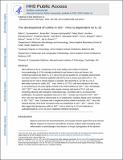The development of colitis in Il10−/− mice is dependent on IL-22
Author(s)
Gunasekera, Dilini C.; Ma, Jinxia; Vacharathit, Vimvara; Shah, Palak; Ramakrishnan, Amritha; Uprety, Priyanka; Shen, Zeli; Sheh, Alexander; Brayton, Cory F.; Whary, Mark T.; Fox, James G.; Bream, Jay H.; ... Show more Show less
DownloadAccepted version (2.452Mb)
Open Access Policy
Open Access Policy
Creative Commons Attribution-Noncommercial-Share Alike
Terms of use
Metadata
Show full item recordAbstract
© 2020, Society for Mucosal Immunology. Mice deficient in the IL-10 pathway are the most widely used models of intestinal immunopathology. IL-17A is strongly implicated in gut disease in mice and humans, but conflicting evidence has drawn IL-17’s role in the gut into question. IL-22 regulates antimicrobial and repair activities of intestinal epithelial cells (IECs) and is closely associated with IL-17A responses but it’s role in chronic disease is uncertain. We report that IL-22, like IL-17A, is aberrantly expressed in colitic Il10−/− mice. While IL-22+Th17 cells were elevated in the colon, IL-22-producing ILC3s were highly enriched in the small intestines of Il10−/− mice. Remarkably, Il10−/−Il22−/− mice did not develop colitis despite retaining high levels of Th17 cells and remaining colonized with colitogenic Helicobacter spp. Accordant with IL-22-induced IEC proliferation, the epithelia hyperplasia observed in Il10−/− animals was reversed in Il10−/−Il22−/− mice. Also, the high levels of antimicrobial IL-22-target genes, including Reg3g, were normalized in Il10−/−Il22−/− mice. Consistent with a heightened antimicrobial environment, Il10−/− mice had reduced diversity of the fecal microbiome that was reestablished in Il10−/−Il22−/− animals. These data suggest that spontaneous colitis in Il10−/− mice is driven by IL-22 and implicates an underappreciated IL-10/IL-22 axis in regulating intestinal homeostasis.
Date issued
2020-01Department
Massachusetts Institute of Technology. Division of Comparative MedicineJournal
Mucosal Immunology
Publisher
Springer Science and Business Media LLC
ISSN
1933-0219
1935-3456